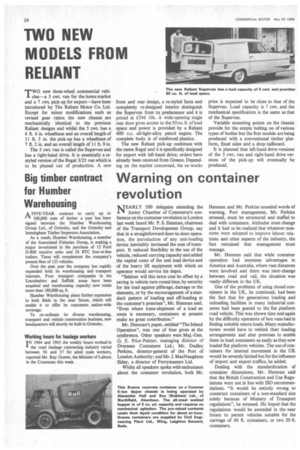Warning on container revolution
Page 28

If you've noticed an error in this article please click here to report it so we can fix it.
NEARLY 500 delegates attending the Junior Chamber of Commerce's conference on the container revolution in London last week heard Mr. P. S. Henman, chairman of the Transport Development Group, say that in a straightforward door-to-door operation, the introduction of any unit-loading device inevitably increased the cost of transport. It reduced flexibility in the use of the vehicle, reduced carrying capacity and added the capital costs of the unit load device and of the heavy lift equipment with which an operator would service his depot.
"Seldom will this extra cost be offset by a saving in vehicle turn-round time, by security for the load against pilferage, damage or the elements, or by the encouragement of a standard pattern of loading and off-loading at the customer's premises", Mr. Henman said. "Even where trans-shipment of a load en route is necessary, containers at present make no great contribution."
Mr. Henman's paper, entitled "The Inland Operation", was one of four given at the conference. Other speakers were Maj.-Gen. G. E. Prior-Palmer, managing director of Overseas Containers Ltd.; Mr. Dudley Perkins, director-general of the Port of London Authority; and Mr. J. MacN aughton Sidey, a director of Ferryrnasters Ltd.
Whilst all speakers spoke with enthusiasm about the container revolution, both Mr.
Henman and Mr. Perkins sounded words of warning. Port management, Mr. Perkins stressed, must be structured and staffed to deal with containers. Attitudes must change and it had to be realized that whatever measures were adopted to improve labour relations and other aspects of the industry, the fact remained that management must manage.
Mr. Henman said that while container operation had immense advantages in America and Australia, where vast distances were involved and there was inter-change between road and rail, the situation was vastly different in the UK.
One of the problems of using closed containers in the UK, he continued, had been the fact that for generations loading and unloading facilities in many industrial concerns had been geared to the flat platform road vehicle. This was shown time and again by the difficulty operators of box vans had in finding suitable return loads. Many manufacturers would have to rethink their loading arrangements and alter premises to enable them to load containers as easily as they now loaded flat platform vehicles. The use of containers for internal movement in the UK would be severely limited but for the influence of import and export traffics, he added.
Dealing with the standardization of container dimensions, Mr. Henman said that the British Construction and Use Regulations were not in line with ISO recommendations. "It would be entirely wrong to construct containers of a non-standard size solely because of Ministry of Transport regulations", he stressed. He hoped that the regulations would be amended in the near future to permit vehicles suitable for the carriage of 40 ft. containers, or two 20 ft. containers.




























































































































